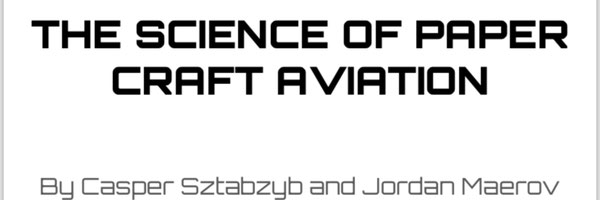The Science of Papercraft Aviation, Casper and Jordan Science Fair Project
Casper Sztabzyb Jordan Maerov
Grade 5
Presentation
Problem
Does different paper weight affect the distance travelled by a paper airplane?
Method
1. Decide on the design for folding the paper airplane.
2. Make a paper airplane launcher so that each paper airplane is launched at the same speed and strength.
3. Buy paper of different weights.
4. Make the paper airplanes.
5. AKA: THE FUN PART. Throw the paper airplanes (indoor, in an auditorium, so there is no wind to interfere).
6. Measure and record the distances the airplanes travel.
7. Throw away the shortest and longest distance for each weight of paper, then average the remaining three distances for each weight of paper.
Research
Paper Weights
You measure paper by how much a ream weighs. The weight of paper can be from 20- 140 pounds per ream. A ream has 500 sheets of paper in it. Copy paper is usually between 20-80 pounds.
What is Lift?
Lift is an aerodynamic force generated by an object rushing past air or wind at a fast speed. When air moves around the object it exerts its force on the object.
Lift is what happens from that force. Lift moves in an up and down direction (perpendicular) as the object moves across the air. Lift is the opposite of drag force, which is what slows down the object that moves across the air.
Lift is an invisible force that keeps the plane up. It can be generated by any part of the airplane, but usually by the wings. This is why we were very careful to fold the planes all the exact same.
What is Drag?
Drag is a mechanical force. It happens when the movement of something (an object that’s solid) interacts with liquid or gas. For airplane and paper airplanes, drag is the aerodynamic foxes that works against their flight. It is aerodynamic friction through the air.
It’s called skin friction because it has to do with rubbing of the molecules of air and molecules of the hard body of the plane or paper airplane.
How do airplanes fly?
An aircraft in stable flight has four forces that act on it. Gravity, lift, thrust and drag.
For our experiment we controlled thrust (with our launcher). Gravity was also controlled. Lift changed with each paper weight. We expected this.
What we realized after reading our results was that there was another factor that changed how far the plane could fly. Drag: drag changes with each paper weight. It could have been the size of the edges of the paper rubbing against the air molecules more. We also think it was because the folds for the airplane can’t be as sharp and tight when the paper is thicker. That probably makes more drag too.
How weight affects flight?
The larger the paper airplane the more it will weigh. The more it weighs the more lift that will be needed to keep it flying.
This is the same for real planes and paper airplanes.
Data
|
Trial 1 |
Trial 2 |
Trial 3 |
Trial 4 |
Trial 5 |
Average |
|
|
20 lbs |
177.25 |
179 |
170 |
190 |
190 |
181.25 |
|
24 lbs. |
171.5 |
137.4 |
109.5 |
139.2 |
127.5 |
137.02 |
|
32 lbs |
185.2 |
245.1 |
187.5 |
250 |
256 |
224.76 |
|
65 lbs |
127.1 |
109 |
210 |
187.5 |
60.5 |
138.82 |
Conclusion
The results prove to us there is more than one factor in choosing the best paper weight for a paper airplane.
While it was true that heavier paper weights travelled further, thicker papers had more drag and didn’t travel as far.
So the hypothesis was partially correct, but did not consider the effect of thickness on drag.
Citations
National Air and Space Museum
https://howthingsfly.si.edu/forces-flight/four-forces
NASA Aeronautics Glenn Research Centre
https://www1.grc.nasa.gov/beginners-guide-to-aeronautics/
Label Planet Paper Research
https://www.labelplanet.co.uk/glossary/ream/
Acknowledgement
We would like to acknowlege Ashlee Tanner. Ashlee works at Westjet and gave us a hangar tour and allowed us to interview her.

